

PORTFOLIO
NEGAR
YAGHOUBPOUR Architecture 2017-2025
Repetition and Rhythm
December 2024


Carved Clay
May 2024

School for Autism
January 2021

Boushehr Stadium
June 2020

Residental Towers
August 2020

General Hospital
January 2020
Responsive Stewart
December 2022


Metal Batwing
December 2019

Lobby Counter
October 2019

Reciprocal Structure
October 2019

Encoded Stereotomy
April 2020

Spring 2017
01 Repetition and Rhythm
Architecture Studio III
December 2024

Music Community Center
Master of Architecture
Instructor: Christopher Reinhart
Type: Academic-Individual
Duration: One Semester
Main Concept
This project connects the music community with its surrounding environment, integrating Noblitt Park through a design focused on transparency and smooth transitions. Moreover, Inspired by repetition and rhythm, the structure aims to create a balanced interaction between built spaces and the natural setting, enhancing the experience of music and the park.


Context and Site
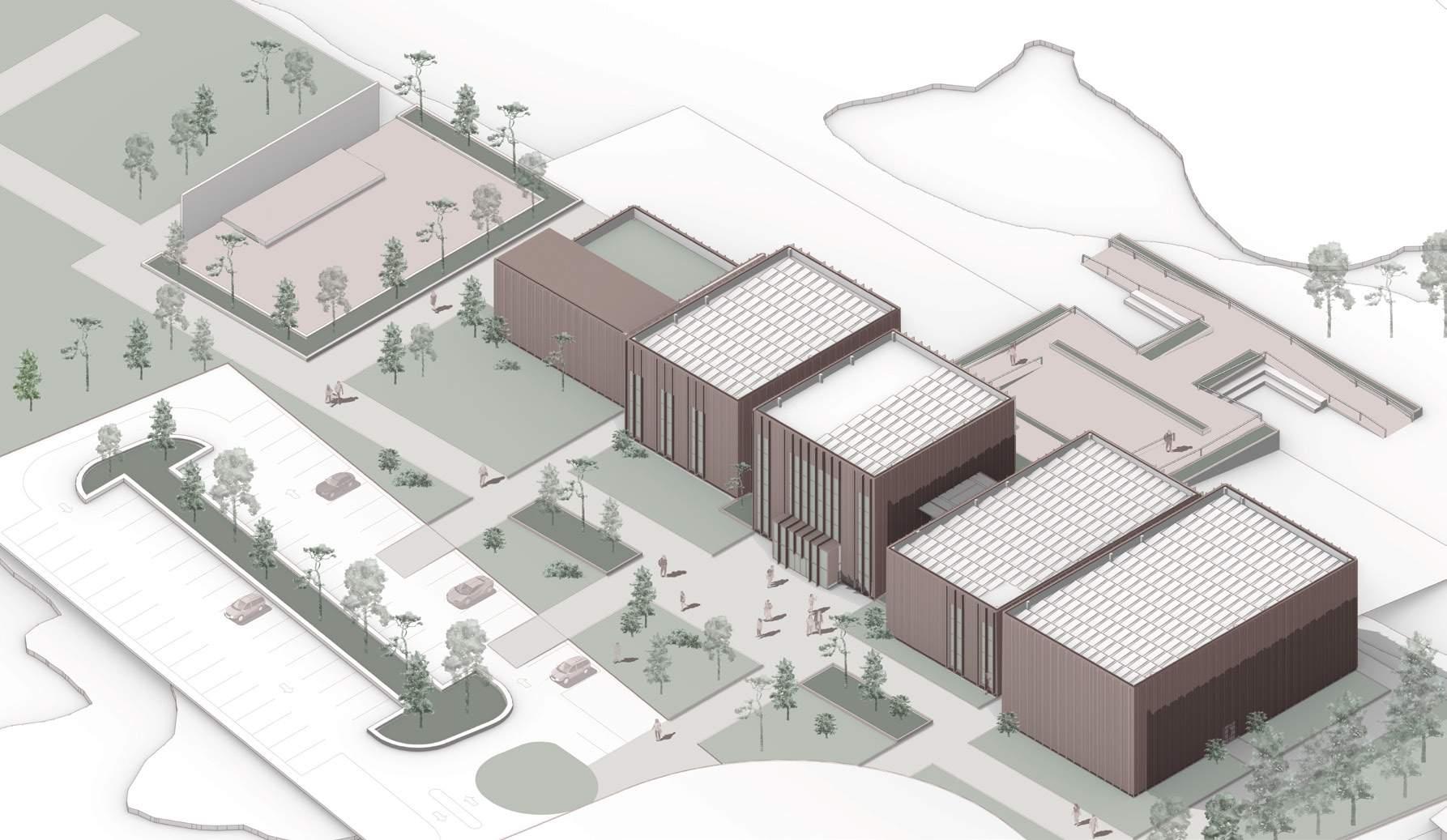

People trail & Noblitt Park

Main Axises Of Connections To Park And Egress
Connection Between Spaces And Moments Of Transparency







First Floor Plan
Second Floor Plan
South Facade
East Facade
Section B-B
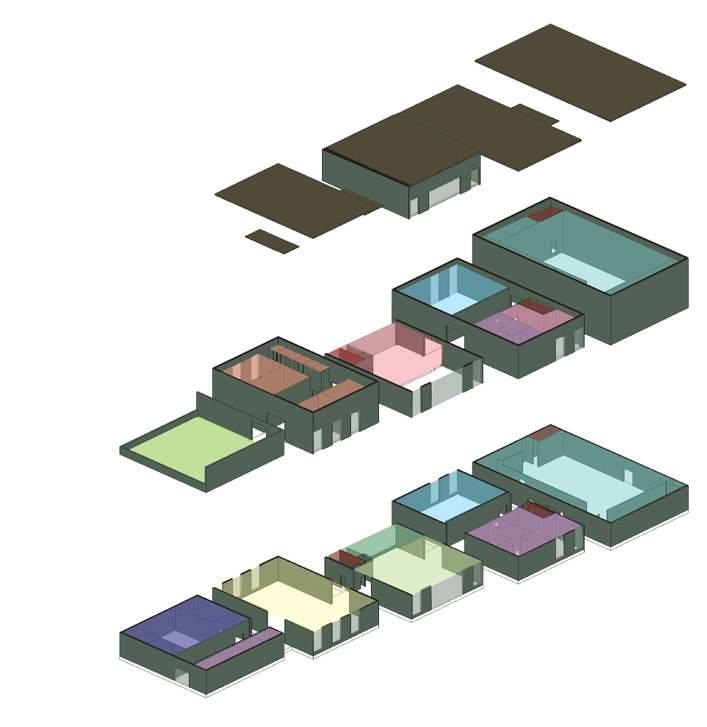



Transparency through the building to the park
Main Entrance/Lobby capturing the park view
02
Carved Clay
Architecture Studio II
May 2024
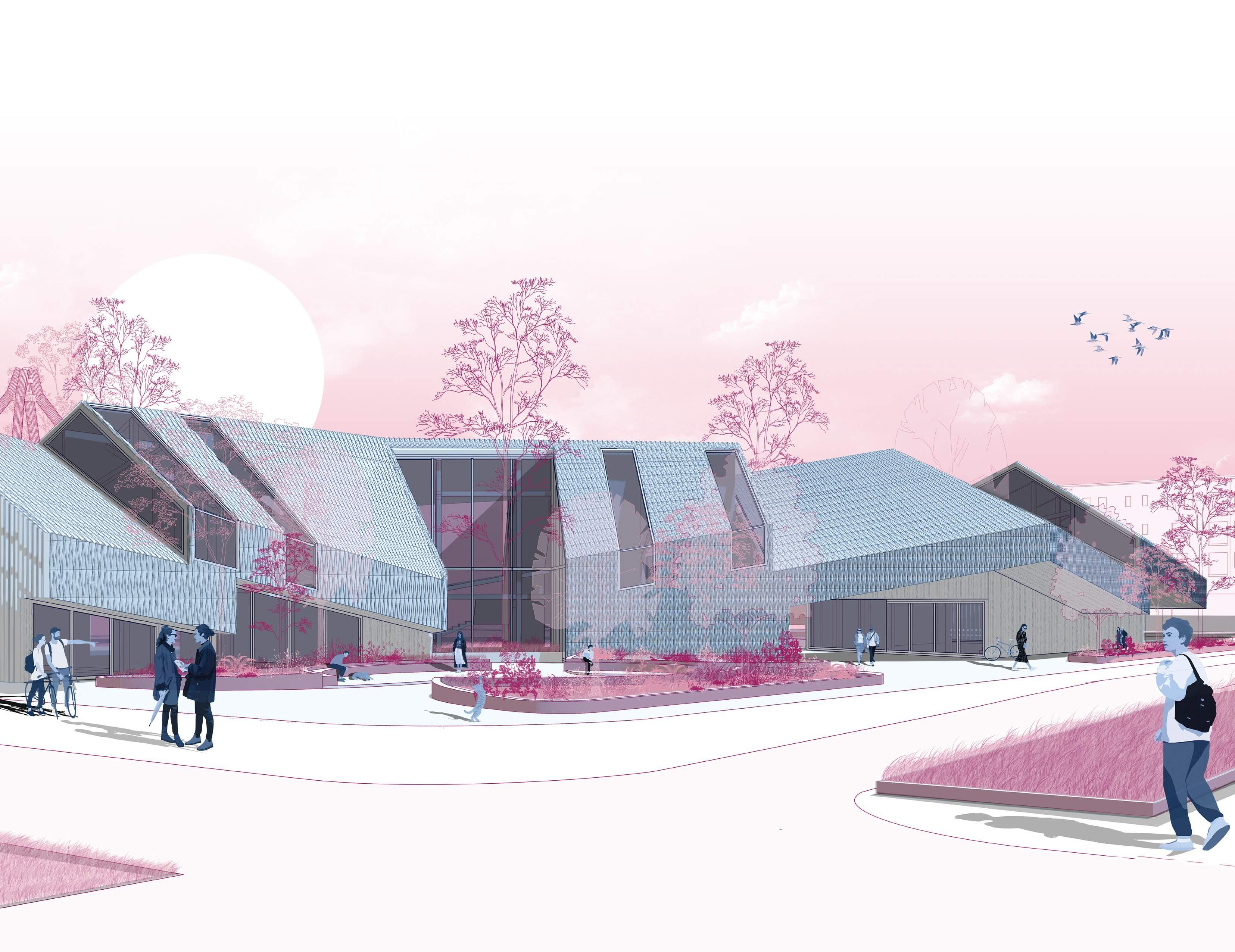
Ceramic Community Center
Master of Architecture
Instructor: Daniel Luis Martinez
Type: Academic-Individual
Duration: One Semester
Preliminary Design Sketches
The preliminary design phase of this project focused on developing skills in casting architectural forms with concrete through an integrated digital and analog workflow. Utilizing Rhino 3D, initial geometries were modeled and subsequently 3D-printed as negative molds for casting. As the design process evolved, formal explorations increased in complexity, with each iteration refining spatial and structural qualities. In addition to studying conventional roof typologies, I focused on engraving and carving the form to enhance material expression and surface articulation.
Moreover, we studied clay and plaster casting techniques, incorporating kiln firing and experimenting with color applications to develop glazed ceramic for facade treatments. Investigating how surface texture and glazing could contribute to architectural expression.

Main Concept

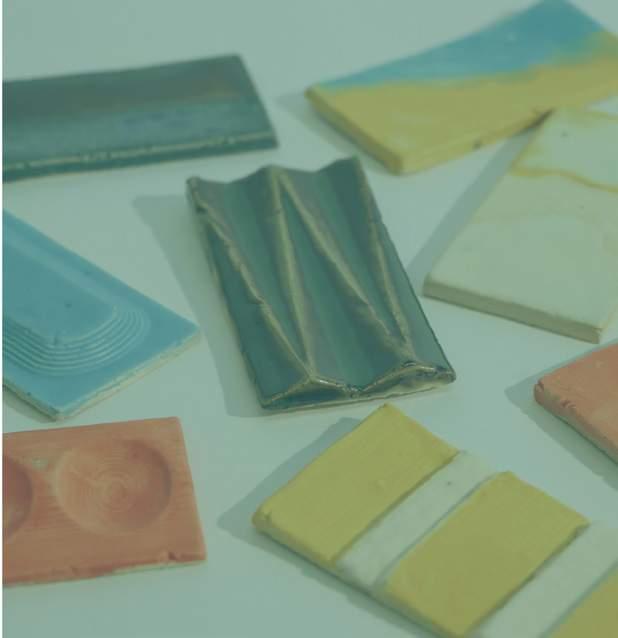


With the site and program being introduced, the architectural design project aimed to blend the building with its landscape surroundings, creating a harmonious connection between nature and the community and use carving as a method to reach that goal. By Carving out the building, the form defines public and private areas, the design not only tries to make the spaces practical but also encourages interaction between indoor and outdoor spaces. This approach aims to create an inviting environment that welcomes community engagement and enhances overall functionality.


Concrete Model and 3D printed Mold
Glazed Tile Studies






Second Floor Plan
South Elevation






East Elevation
Common Workspace
01 School for Autism
Final Design
January 2021
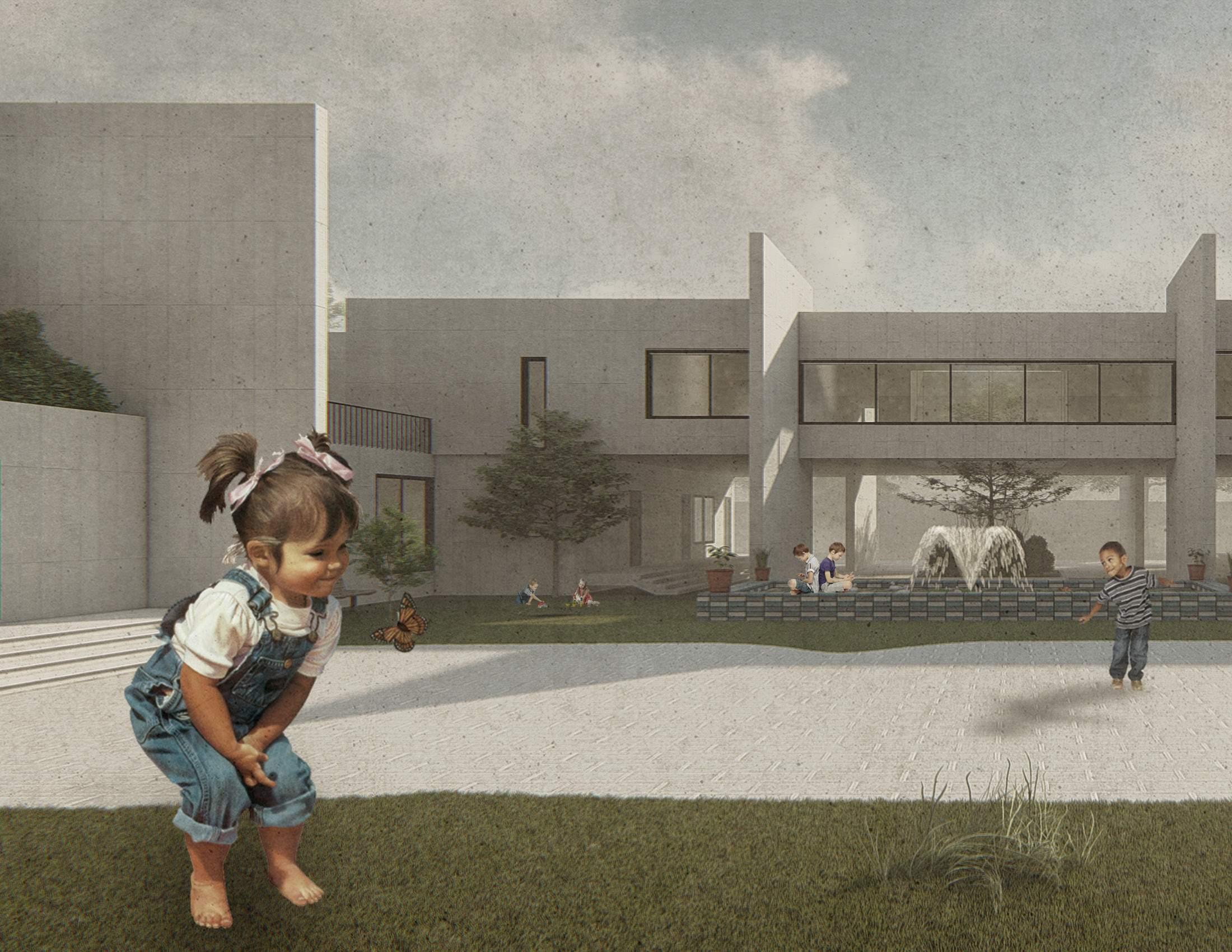
Educational and Rehabilitation Center
Bachelor of Architecture
Instructor: Shirin Azhdehfar
Type: Academic-Individual
Duration: One Semester
Main Concept
In the last century, the knowledge of autism and its treatment methods have developed and efforts have been made to provide a better educational condition for these children, although in our region it is not going at the same pace. After research in this field, I found out that one of the best ways to educate and treat children with autism is to provide them with a dedicated learning environment so that they can benefit from up-to-date methods in small groups for more focus on individual students. The main purpose of designing this school is to create a suitable space for autistic children that follows the principles of a suitable environment for their comfort and greater productivity according to the research result.
School Zoning

Due to the lack of specialized personnel in the field of treatment and education of autistic children, it was decided to allocate a part of the complex to specialized education for teachers. Also, the educational section was divided into two groups so that the focus of care and education can be maximized and its environment becomes more suitable for each age group
Form Finding Process

4. Eventually, an effort was made to make each part of the building recognizable to children from the exterior view, which can be significantly helpful for the kids.
3. Reduction in each section was done to create terraces and more lighting.
2. Each age groups building, as well as the teachers' department, would have its individual yard.
1. The initial stain was excavated to create yards that are sunny all year round and volumes that can be divided functionally.

Structure and Facade
1. Use of shear wall for larger openings
2. Beams and columns connection
3. Connecting escape and decorative stairs to the structure
4. The utilization of shear walls in the facade of the building inspired by the works of «Tadao Ando»
5. Consuming white concrete and not using too many colors that make autistic children distracted

Site Location
In Tehran, autistic children's schools have difficult access to deprived areas. Therefore, after the investigation, the school site was placed in one of the southern areas of the city, which had proper access as well as the necessary facilities.


Each class has its own yard. Also, an indoor playroom is placed in each building.
School Entrance

Classrooms
For better control of children, classes of five were designed also each class has a semi-private yard. In addition, Inside and outside the classroom, there is a space for kids' play therapy.
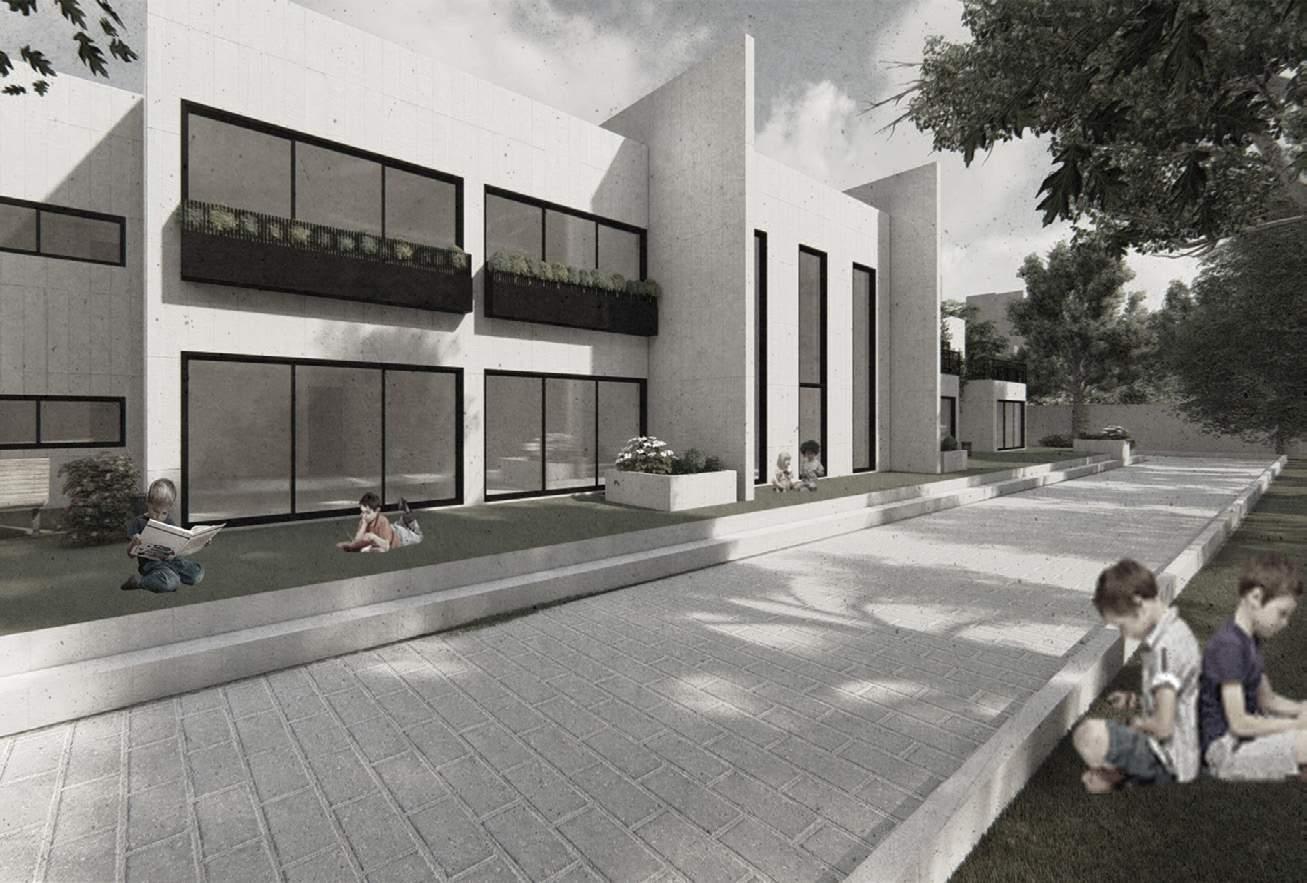

02 Boushehr Stadium
Design Studio V June 2020

Sports Complex
Type: Academic-Group Work
Teammate: Alireza Alikaei
Position: Responsible for all tasks
Duration: 1 Semester
Main Ideas
Due to the spread of the corona virus, the semester was extended until the middle of summer. Therefore, after consultation with our professor, we decided to design a voluntary project in this studio. Later, the concept of this project was developed. In this project, the goal was to design a stadium with the approach of creating a favorable urban space along the Persian Gulf coast. The main focus of the project was on the football stadium and the rest of the functions were developed on the site. In this stadium, the form follows its function as much as possible to be a user-friendly space. Also, its scale was an essential factor in the urban space, which was tried to be placed in the best part of the coastal city of Bushehr, which has hot and humid weather.
Site Development
The bubble diagram was designed to form the main scheme of the stadium and its master plan. Thus, the best connection between different locations of the complex could be made.


Entrance and Parking Locations

Main Functions Locations
After establishing the physical program, different locations were placed on the site considering their essential connections. Then, the stadium and the site were developed.
Design Process
The Stadium form was inspired by the form waves and boats of Bousher›s sea and the softness of the site stadium exterior combinations unified the complex.





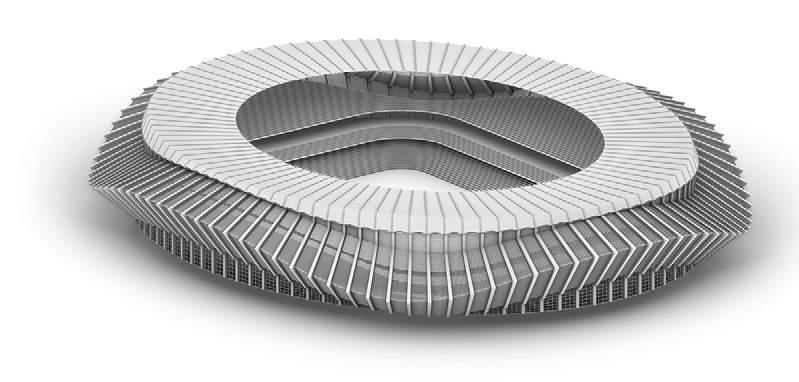
Form and Facade Description
In addition to static and resistance, it was tried to design a harmonious and suitable complex for Bushehr. In the stadium, the roof structure is separated from the platform structure. The exterior structure consists of 100 metal columns and the roof structure ware supported by the outer shell columns. The final roof covering is formed by ETFE panels in the form of a ship and the elements form are inspired by the cultural motif of Bushehr Shenashir(Mashrabiya).

Shenashir
Simple stadium seats
Shrinking the base for entrance
Oval split of seating area
Roof fabric shade
Exterior extrusion
Final touches

According to the FIFA world standard for football fields, it is better for the stadium and football field to rotate 15 degrees north to the west so that the sunlight on the field is optimal for players and spectators.
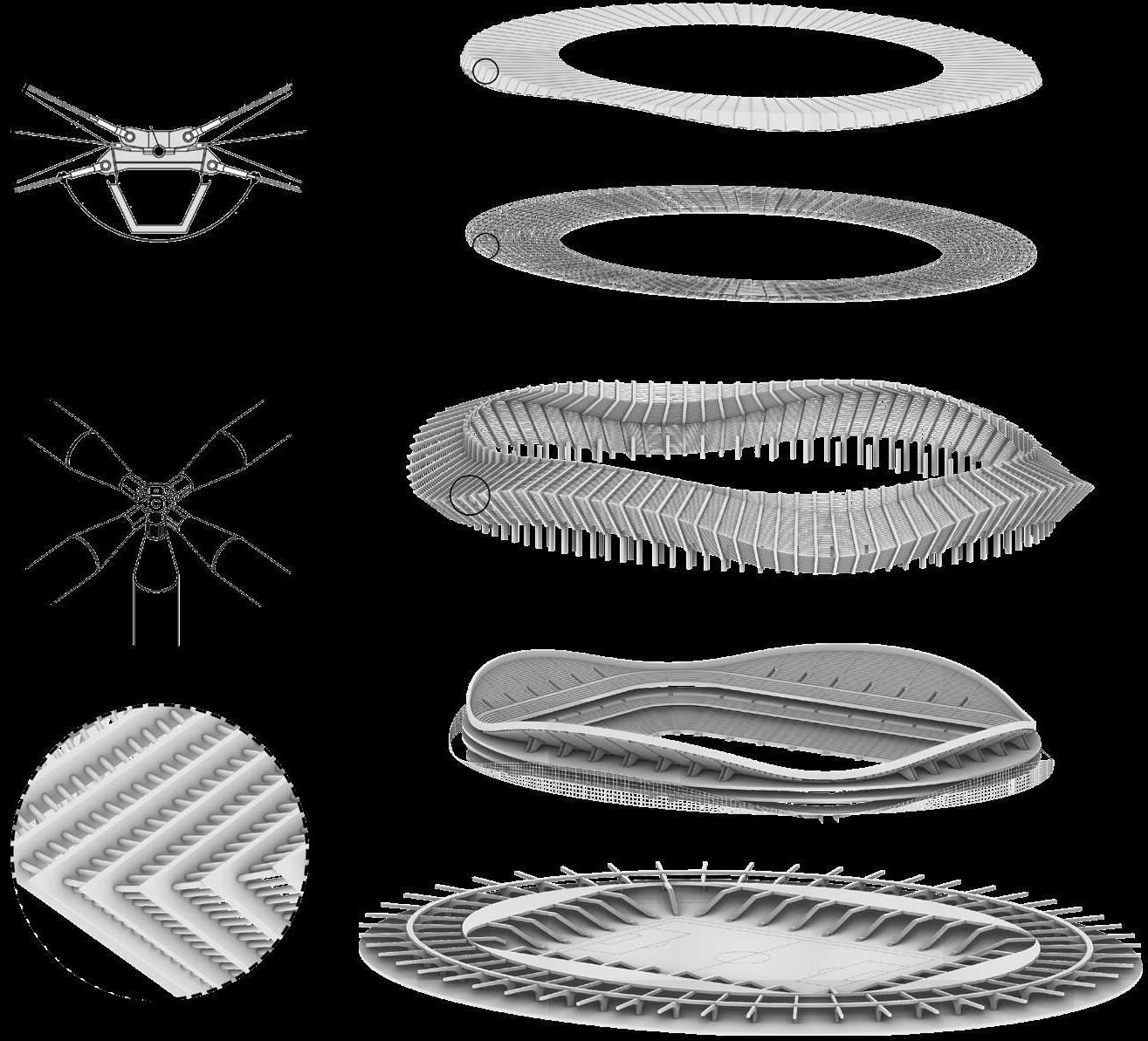

Special Section for the Disabled and Companions
First-Floor Platforms
Third-Floor Entrance
VIP Rooms and TV studios
Third Floor
Exterior Shell
Trusses Connection
Roof Panels Connection




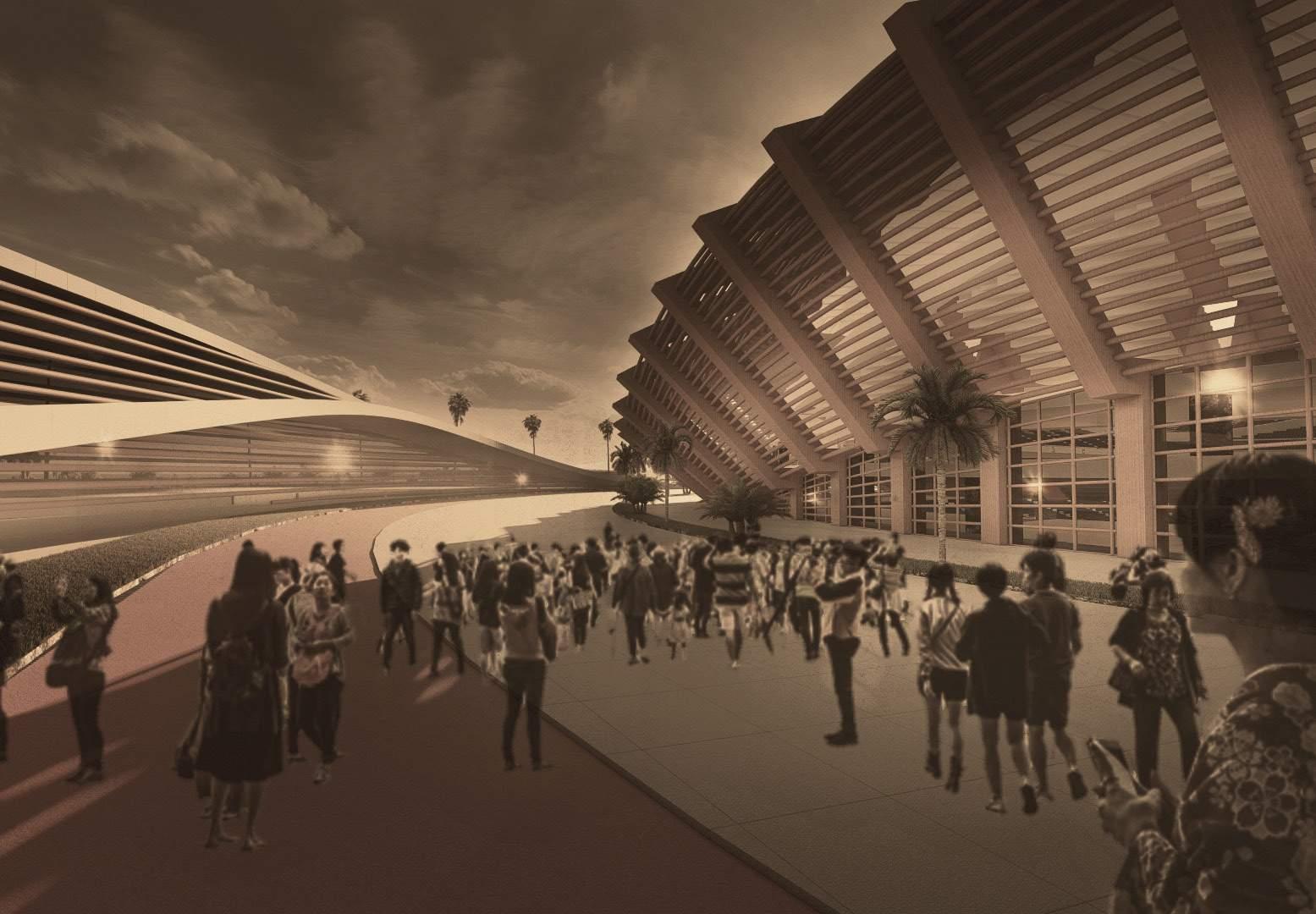
03 Residental Towers
Design Studio V June 2020

Residential Complex
Instructor: Shirin Azhdehfar
Type: Academic-individual
Duration: One Semester
Main Ideas
This studio focus was mainly on residential buildings and we had to design a complex for Tehran citizens. Besides, Towers are inevitable for a crowded city like Tehran and They are one of the best ways to accommodate people in populated cities. In these towers, an attempt was made to increase social interactions by creating common spaces. It was also tried to meet the basic needs of the residents in the tower itself to save time and energy, so facilities such as a primary school and banks, etc were built on the site. Moreover, green spaces and maximizing lighting were other factors influencing the design for a dynamic residence.
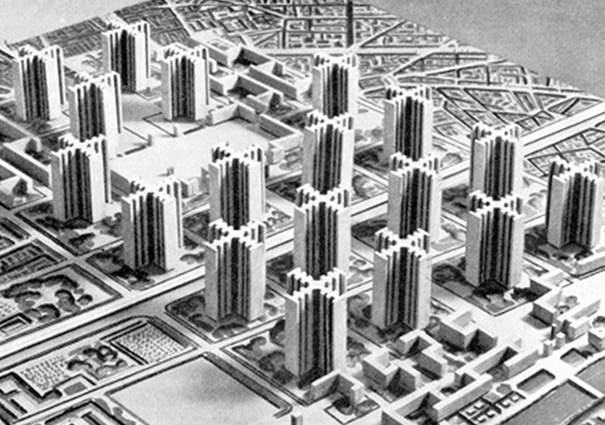
Social Interaction
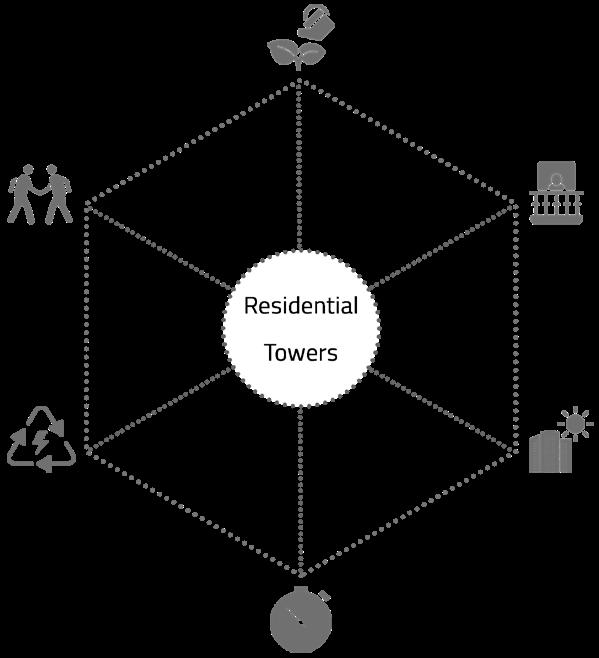
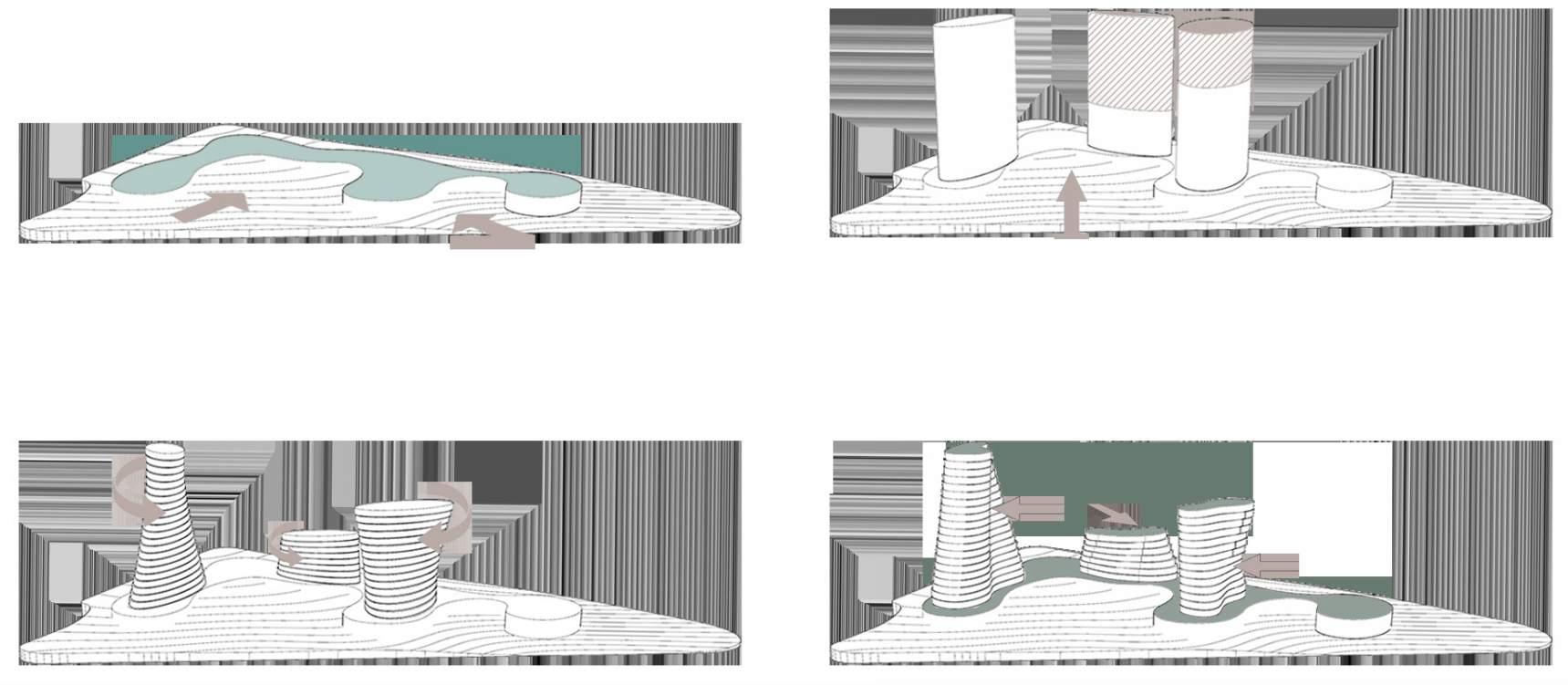
The initial stain was placed considering yards and site topology
Towers were extruded and some levels were eliminated for better sunlight and view
Floors were rotated for creating terraces and various views
Some faces were compressed for functional structural design
This concept was mainly inspired by Le Corbusier’s Garden City in which he tried to fulfill the populace main needs in their towers and he tried to use roofs as an important area which had been useless before that, also the last essential aspect of that design was gardens and green areas which was tried to be utilized as much as possible.
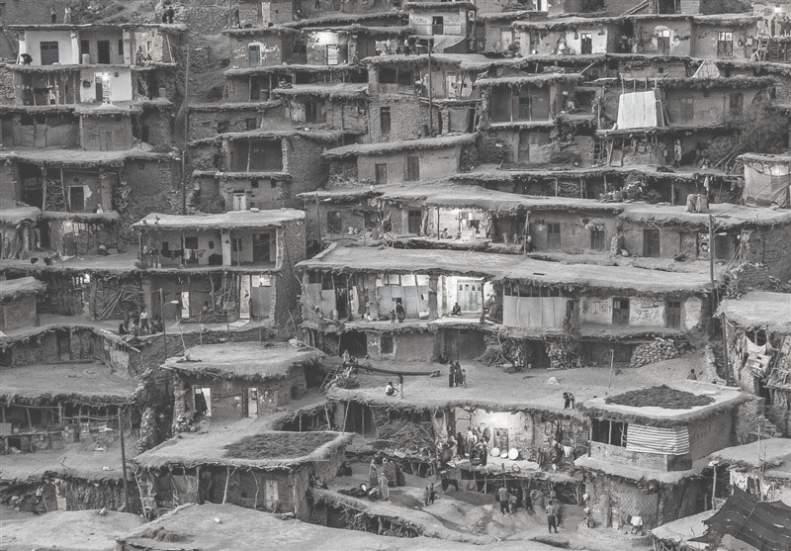
Another influential case was the village of Masouleh in the north of Iran, in which each roof is the yard of the upper houses, and in these towers, shared terraces were used as a shared area in each level.

Plan Modules
Most units follow this model, but on the outer edge, they differ according to the external form and have a decrease or increase in the size of the area. Windows of bedrooms and living rooms open to the shared terrace of each floor.



Green Roofs
Green Roofs
Residential Area
Bank, Supermarket, Shops
Pool, Playground, Gym
Elementary School
Parking Parking

Facade Pattern
To control the incoming light and play with shadows, a traditional Iranian motif called Mashrabiya was used. This pattern was designed to control the light and it was implemented in the amenity floors only.




Light Income Analysis
Mashrabiya Module
04 General Hospital
Design Studio IV
January 2020

Health Care
Instructor: Shirin Azhdehfar
Type: Academic-individual
Duration: One Semester
Design Process
In this studio, designing a new general hospital for the expansion of Mofateh Hospital was assigned as a project for students. The main purpose of this studio was resolving the relations between the main departments of the hospital for a more convenient movement of patients and also the creation of a much more lively atmosphere. Moreover, designing functional plans was very essential especially the ground floor plan, in which the emergency department is located, as well as the inpatient wards plans designing.


These diagrams were designed to divide outpatients and inpatients in a way that communication between hospital departments can be done as quickly and easily as possible.
Final touches for a suitable form and green roofs.
Compressing some parts for maximum light and better division between departments.
Extruding the surface with a gap in between for better light and air conditioning.

Placement of the stain on the site, considering the best entrance for the emergency room and the lobby.
Ground Floor
Facade Construction
The connection of the shell to the building can be accomplished by a mesh that will be installed behind the shell and will be placed in the concrete layer of the wall. The shell can be divided into squares and each one of them will be molded separately, then they will be installed next to each other.


Inpatient wards were designed in a way that patients can be taken care of in the best possible condition. Also, each room has an entrance to the terrace to provide a more

Facade concept
The hospital facade shell was inspired by the form of the human body cells, which makes the hospital look like a living thing that promises hope for its clients.


05 Responsive Stewart
Stewart Robot
December 2022

Computational Design
Type: Voluntary - Group Work
Teammates: Alireza Alikaei, Mehdi Akbari
Position: Responsible for all tasks
Duration: Three Months
Main Ideas
Our goal in this project is to practice the construction of industrial mechanisms that are being evaluated in the field of digital architecture nowadays. In this project, these mechanisms have been tried to be controlled by Grasshopper, which is one of the designers' tools in the field of digital design. These algorithms are written by Fire Fly’s component that enters the input and output data of the Arduino kit into the Grasshopper environment. This approach allows us to utilize mechatronics in our design process as a tool or concept in the future.
In the first phase, the Stewart robot was examined. Its mechanical arms were drawn in Rhino and next those were fabricated with plexiglass material by 2D CNC. Finally, it was launched in Arduino, Firefly, and Grasshopper.
The main mechanism of this robot is the rotation of the G996 R servomotor shaft, which moves each arm. This robot is controlled by three inputs. Controlling it with the Grasshopper number slider in the range between 18 and 120 degrees, Controlling it with random numbers between 18 and 120 degrees generated by Python code, and controlling it with the data extracted through the ultrasonic sensor. In this project, all were examined.
Mechatronics
Mechatronics is a multidisciplinary field that refers to the skill sets needed in the contemporary, advanced automated manufacturing industry. At the intersection of mechanics, electronics, and computing, mechatronics specialists create simpler, smarter systems. Mechatronics is an essential foundation for the expected growth in automation and manufacturing which could be usable and profitable for today's architecture as well.
Mechatronics deals with robotics, control systems, and electromechanical systems which consist of mechanics, electronics, software, and control.

Mechanic
Stewart robot can be constructed by various mechanisms, in this project the mechanical arm mechanism has been used to create faster movement and reaction. In this method, the arms are rotated from the middle by a servomotor and the main plate, which is connected to the arm by magnetic balls, will rotate at different angles and in different axes.
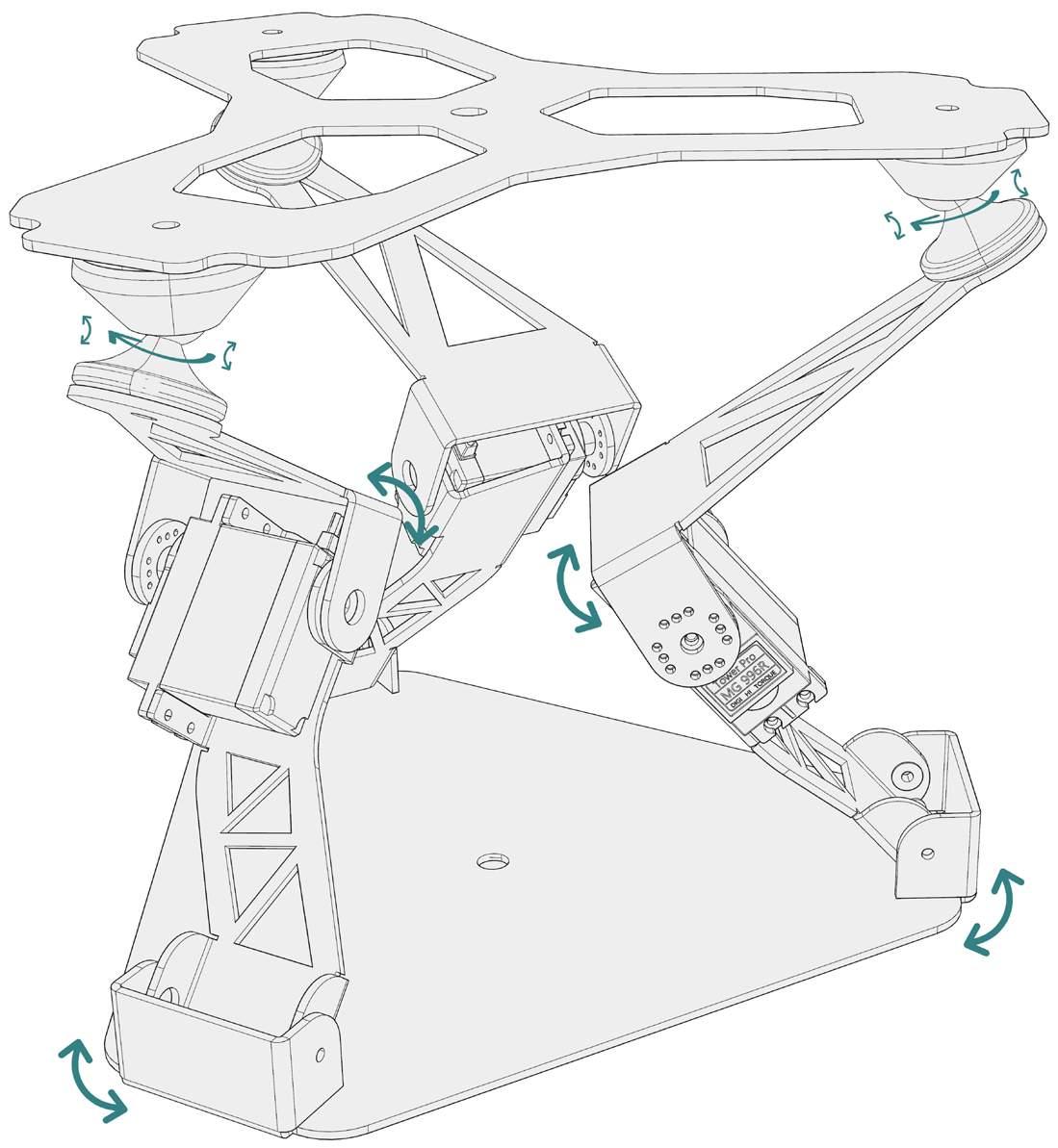




Software
Setting up this Stewart robot consists of two general steps:
1. Sensor (reading the distance through ultrasonic)
2. Arduino (writing the servo rotation degree) These processes can be accomplished with the use of grasshopper, Arduino, and Firefly.







Servo Mechanical Arm
Mechanical Arm Magnet
Servo Motor Sensor Reading Process Servo Motor Rotation
Control
In total, in the two steps, which were explained in the software section, the input of the system is the data obtained from the ultrasonic sensor, which is read by the New Ping library in Arduino and stored on the first Arduino. This data is entered into the Grasshopper by Firefly and is converted into the input data of the second Arduino, and finally, the second Arduino code is generated by the Grasshopper so that the servo motors work with the data obtained from the ultrasonic. It should be noted that these two processes are done in 20 milliseconds.
Input

Process
Sensors
Process one: Sensor Reading Algorithm
1. Specifying each Arduino to write their individual algorithm
Grasshopper Firefly Arduino

Output
2. Reading Ultrasonic data
3. Converting the obtained distance number into operational data for another Arduino
Servo Motor Rotation (Panel Movement)
Process two: Arduino Coding Algorithm for servo rotation

4. Angle rotation command to servo motors
06 Metal Batwing
Minimal Surface Practice
December 2019

Computational Design and Fabrication
Type: Voluntary Personal-Group Work
Teammates: Alireza Alikaei, Mahshid Amani, Sina Rezaeifar, Samar Yazdanfar
Position: Responsible for all tasks
Duration: Two Months
Batwing Minimal surface
In mathematics, a minimal surface is a surface that locally minimizes its area. This is equivalent to having a mean curvature of zero. Minimal surfaces can be defined in several equivalent ways in R3.
The design of this project is basically a Batwing Minimal surface. The Batwing is a type of triply periodic minimal surface that was discovered by Alan Schoen.
It can be trigonometrically approximated by a short equation:
Cos(x) sin(y) + cos(y) sin(z) + cos(z) sin(x) = 0






Form-Finding by Grasshopper & Kangaroo
First, a mesh plate with the logic of batwing minimal surface was modeled in the form of a sharp corner. Then, supportive lines and effective points were extracted from the initial mesh, and after that by the kangaroo plug-in and the extracted data, the tensile shell was created. In the end, the surface was manipulated to conform to the fabrication.




Evolution of a Schoen Batwing Minimal surface
Subdivision by Ivy
At this stage, the shell was subdivided by the utilization of the Ivy, a Grasshopper plug-in, and the developed algorithm. These created pieces were required to be fabricated by the use of the folding method with bendable and shatterproof material.
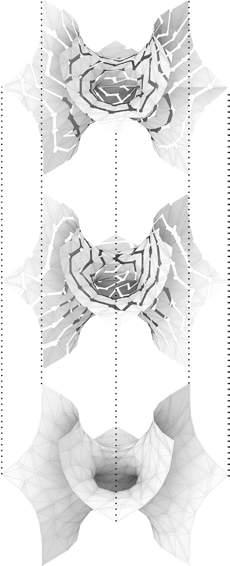

Fabrication




After extraction of the twodimensional pieces from the shell, it was decided to utilize iron material for making the segments. Firstly, 2D plans were presented for using iron laser cut. Secondly, a method called Bridge-Building was utilized in the joint points. (This was done after a consultation with a mechanical engineer). In the final step with the use of argon welding, the point was assembled. CNC segments Joint details for Folding

Final Result
After the assemblage, it was observed that the work was done with surprisingly high accuracy, the word surprise is used because this project was our first practice (experiment) of working with iron metal and lasercut, which were strikingly precise.






07 Lobby Counter
University Lobby Design and Fabrication
October 2019

Interior Design
Type: Voluntary Personal-Group Work
Teammates: Alireza Alikaei, Sina Rezaeifar, Samar Yazdanfar
Position: Responsible for all tasks
Duration: Three Weeks
First experiment toward Digital Fabrication
Counter design project for a lobby of the University of Science and Culture was assigned to this group by the director of the department of the faculty (Dr. Habibi). The entrance lobby of the amphitheater and the university exhibition had to be designed and constructed at the lowest cost within three weeks at the request of the president of the university. This opportunity was utilized as the first experience of professional digital design and manufacturing. This project was also the first experience of working with a wood CNC machine to make the outcome of the contoured object accurate in shape and size.
CAD Process
Since this was a practice in digital fabrication, the focus in this experience was more on algorithm writing and plan extraction and the base surface was inspired by an existing project. In this part, after modeling the shells, the contouring approach was chosen for construction. Next, the shell was cut in equal distances vertically for creating segments, and then the surfaces were extruded 16 mm, which is the usual dimension of the MDF plate.

Contouring the forms



CAM Process
In this part, plates were separated and numbered by grasshopper. In order to optimize the outcome and reduce material waste, surfaces were placed in 2500x1200 mm plates. Then we performed the G-code process by Autodesk PowerMill. Finally, 683 pieces were produced in the workshop for construction.
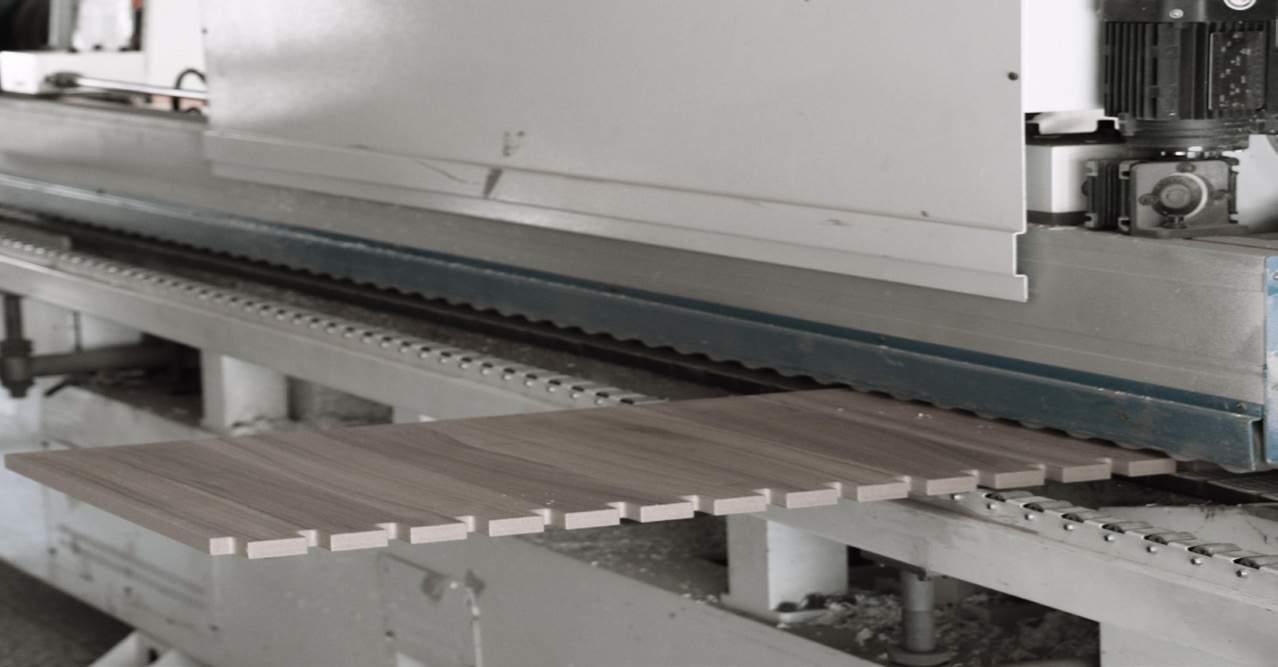




1250*2500 MDF sheet
Construction
The whole construction process took a week, to assemble the pieces, according to the code engraved on them, they were put in place like a puzzle. The tongue-and-groove joint technique was used to join the parts also wood glue was utilized to make them stronger.



08 Encoded Stereotomy
Free Form Funicular Shell
April 2020

Computational Design and Fabrication
Supervisor: Dr. Ali Andaji Garmaroodi
Tutors: Farzaneh Eskandari, Pouria Baniadam
Assistants: Reza Fattahi, Sepehr Farzaneh
Position: Participant/Designer(Modeling,G-Code Developing)
Type: Workshop-Group Work (40 participants)
01. Group Alternatives
The workshop was attended by 38 students and graduates from various universities, participants were divided into groups of 6 to 8 and were asked to first draw their ideas for a compression only vault individually, and then in consultation with team members, an idea was selected and developed in each group. After two working days, all the designs were reviewed by the directors, and finally, after examining the strengths and weaknesses of each, one of the designs was selected for construction on a one-to-one scale.
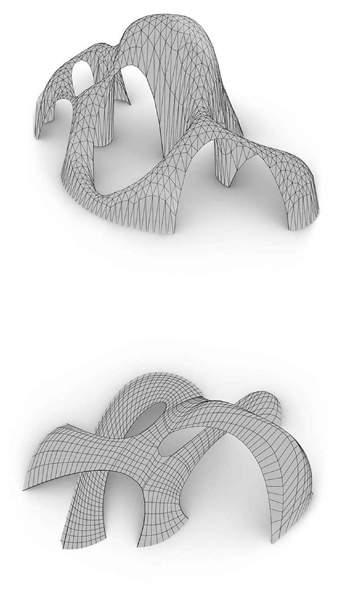
02. Concept Development



One of the ideas put forward by the participants consisted of arches that had crossed each other at different heights. This idea was chosen as the final design for construction due the innovative form of the each compared to other ideas put forward by the participants and also to similar projects made in the field of compression-only structures. Another advantage of this form over other ideas was the low surface area of the material intended to cover a wide span. The complexity of the form was also visually appealing to the participants.
The main challenge in developing the selective idea was to maintain the horizontal and vertical proportion of the vault spans. For this reason, many Alternatives were modeled to obtain the desired form in Rhino Vault software.



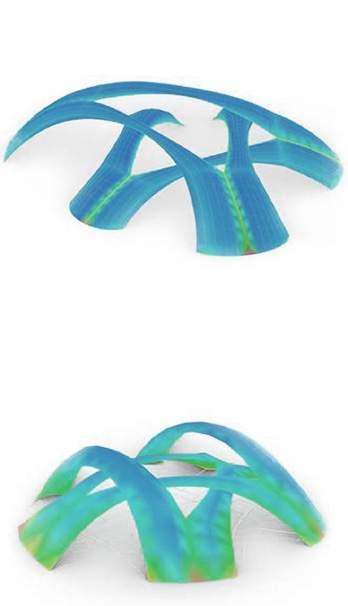
03. CAD Process
After adjusting the proportions of the selected form, the relevant analyzes for generating a vertical vault were performed with high accuracy in rhino vault, Next, the mesh curvature was evaluated to make the hot wire CNC foam cutter capable of cutting the voussoirs. The obtained mesh by Rhino Vault was not completely planar, Therefore, in the first step, the deviation of the mesh panels from the planar state was reduced to the minimum without causing any tangible deformation in the vault form; and after that the ruled surfaces which are perpendicular to the original rhino vault mesh were split by two parallel planes, and the six obtained faces were prepared for cutting.

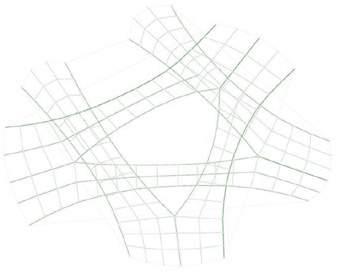



04. CAM Process
At this point, all the modeled voussoirs were ready to be cut, so for the cutting the parts by hot wire CNC foam cutter, the G-codes for the arranged voussoirs were generated by «Solid Works» and all the pieces were cut in about five days.





Generation of The Voussoirs
In order to prevent sliding failure and guarantee structural stability, the main load bearing faces of neighboring voussoirs need to be perpendicular to the force flow. Therefore, the interface surfaces should be normal to the thrust surface at any point.


In order to avoid loss of materials and to increase the cutting speed, it was attempted to arrange the designed vault voussoirs in 100 * 100 * 10 cm3 polystyrene sheets by use of Rhino-Nest. The cutting tool of the machine is moved according to the g-code instructions through a tool path, cutting away material to leave only the finished work piece. G-code is a language in which people tell computerized machine tools how to make something. The «how» is defined by g-code instructions provided to a machine controller (industrial computer) that tells the motors where to move, how fast to move, and what path to follow. The G-codes of this project were generated with 3D modeling software called «Solid Works» and the machine process was simulated in «Solid Cam».
Mesh Isometric View Force diagram
Planarized Mesh
Curvature Analysis
05. Construction
After finishing the cutting process, students began to assemble the pieces using polyurethane foam, the process of assembling the vault was completed within a week, after which the cement coating was applied on the final vault.



Assembling Arrangement





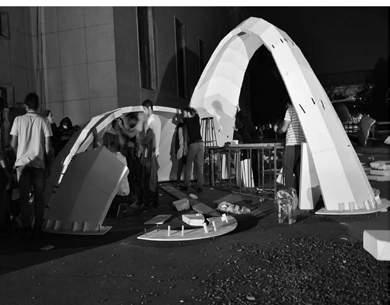





09 Artworks
Introduction to design II (Installation and performance) Spring 2017
Supervisor : Dr. Ali Javdani
Assistants : Mohammad Ahsani, Adib Khaeez, Soroush Modirzadeh
Position: Installation Designer/ Performance Designer/ Set Designer/ Actor/ Scenario Developer
Type: Academic-Group Work













